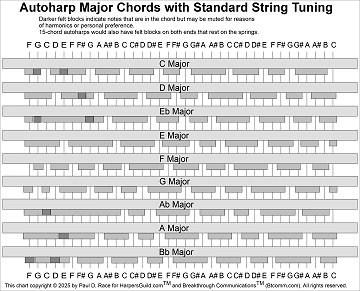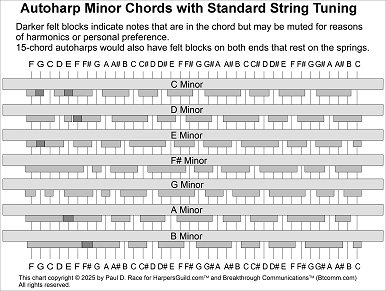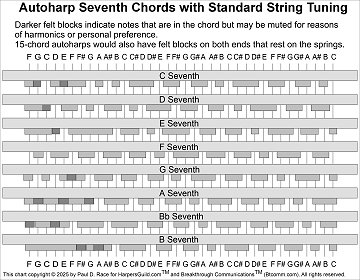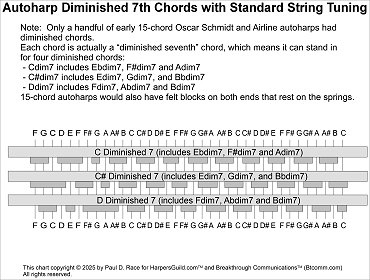 Standard Autoharp Chord Bars |
| 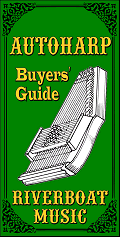

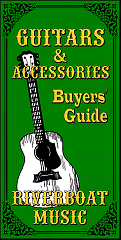
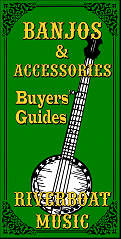
| Standard Autoharp Chord BarsAs of this writing, only four factory-built autoharp models have been made consistently for the last thirty years - the Oscar Schmidt 15- and 21-chorders and the Chromaharp 15- and 21-chorders. All four of these (and several others made in the past) use the same string tunings and chord bar designs. We're not enamored of them, necessarily, but they create a starting point for anyone tweaking or repairing one of these instruments.
CaveatsBefore doing anything permanent to your autoharp, you should probaby know a few things about how what these charts show and don't show."Optional Strings Our chord bar charts shows some of the lower strings as being optionally open or muted (dark grey blocks). Different manufacturers and autoharp designers will make different choices, depending on one of these issues:
If that's not complicated enough, Oscar Schmidt autoharps from different years go back and forth on some of those notes. In other words, they're optional. If you're repairing or reconfiguring your own autoharp, how you deal with those notes (shown by the dark gray blocks) is up to you. If you're just using this chart to help you identify your mixed up OS21 chord bars, ignore the dark gray felt blocks. They could be open or muted on your chord bars. Look at the rest of the felts instead. 15-Chorder Bars vs 21-Chorder Bars If you have a 12- or 15-chorder, the felts extend all the way to the end of the bar. They rest on the springs. The chord bars in this chart are designed like the 21-chorder bars, which have no felt on the ends. That said, the REST of the felt blocks are the same, whether you have a century-old OS73 or a brand new OS110. If I had infinite time, I'd draw the chord bars both ways, but I respect your intelligence, and I have to respect my other commitents. Chord Bar Sequence - We didn't attempt to put the chord bars in the same sequence as you'll see them on your autoharp, because different autoharps arrange them differently. And not all of the chord bars shown appear on every harp. (In fact E major, B minor, and F# minor appear on almost none of them.) Note: We did not include any chords that are "missing" on virtually all autoharps. For example, no standard autoharp has F minor or B major. If you want to make a chord bar that isn't represented in our charts, contact us. and we'll try to help. String Spacing - Our charts are designed so that if you print the PDF version at 100%, the strings and felts should line up to your autoharp's real strings and felts. However, autoharp manufacturers have to retool every so many years, and every time they retool, there's a chance of the string spacing changing slightly. So, before you use our charts to do some massive rework on your autoharp, make certain, the chart is lining up with your strings properly. You may have to print the chart at 99% or 101% to get it to do so. In addition, our articles on tweaking and reconfiguring autoharps also offer some tips that may help you get through repairs regarding chord bars, springs, etc. As I have time, I'll write more specifically about these problems and others you may encounter. In the meantime, I hope our available articles help answer your questions about these under-rated instruments. Chord Bar ChartsClicking on any of the illustrations below will link you to a printable full-sized PDF file. If you print it at 100%, the string spacings should be the same as the string spacings on your autoharp. But make certain they are before you start cutting things.
And please stay in touch!
|
|
All material, illustrations, and content of this web site is copyrighted ? 2001, 2002, 2003, 2004, 2005, 2006, 2007, 2008, 2009,
Note: Creek Don't Rise (tm) is Paul Race's name for his resources supporting the history and music of the North American Heartland as well as additional kinds of acoustic and traditional music. For questions, comments, suggestions, trouble reports, etc. about this page or this site, please contact us.
| ||||||||||||||||||||||||||||||||||||||||||||||||||||||||||||||||||||||||||
